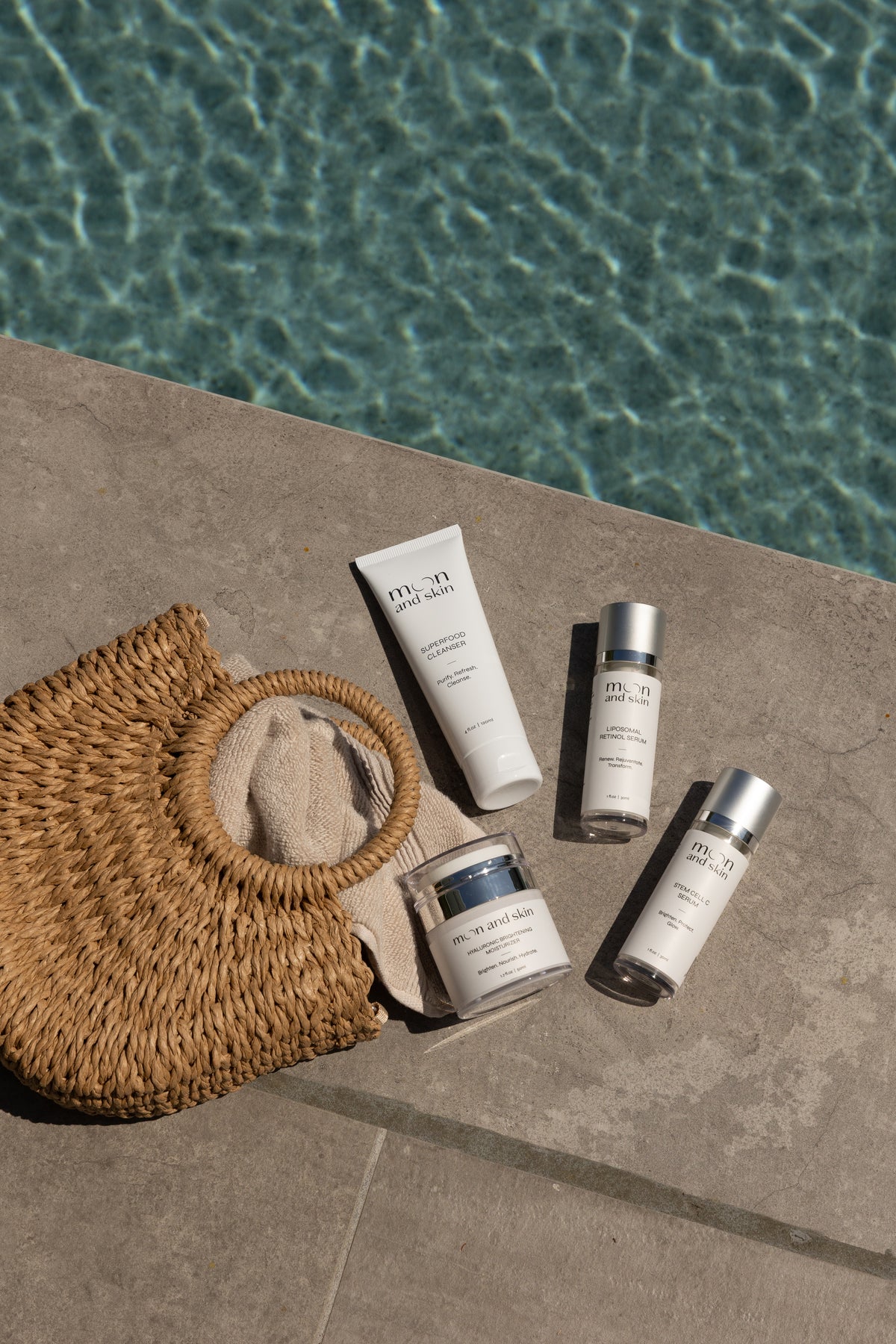Table of Contents
Introduction
Have you ever stood in front of a skincare aisle and felt overwhelmed by the plethora of choices? You're not alone. The skincare industry presents a dizzying array of products, each promising to transform your skin. But the key to effective skincare lies not in the number of products you own but in finding the right routine tailored to your unique skin needs.
Today, we’re diving deep into how to find the right skin care routine, a journey that begins with understanding your skin type and concerns. In a world where clean and thoughtful formulations are often overlooked, we at Moon and Skin prioritize empowering you with knowledge to make informed choices.
Our goal in this blog post is to guide you through the steps necessary to establish a skincare regimen that suits your skin, celebrates its uniqueness, and adapts as it changes with the phases of life. Together, we will explore how to identify your skin type, understand common skin concerns, and build a routine that enhances your skin's health and appearance.
Understanding Your Skin Type
The foundation of any effective skincare routine is a thorough understanding of your skin type. Knowing what category your skin falls into allows you to select products that will work in harmony with your skin rather than against it. The five main skin types are:
- Normal Skin: Balanced, not too oily or dry, with few imperfections.
- Dry Skin: Often feels tight, may be flaky or rough, and can be prone to irritation.
- Oily Skin: Characterized by shine and enlarged pores, often prone to acne.
- Combination Skin: A mix of dry and oily areas, typically oily in the T-zone (forehead, nose, and chin) and dry on the cheeks.
- Sensitive Skin: Easily irritated and reactive, often red or inflamed, requiring extra care.
Understanding your skin type is crucial for determining the right products to use. For instance, those with oily skin might benefit from lightweight, oil-free formulas, while dry skin types may require richer, more hydrating options.
Identifying Your Skin Type
To determine your skin type, we recommend a simple test:
- Cleanse your face using a gentle cleanser. Rinse and pat dry.
- Wait for an hour without applying any products.
- Observe how your skin feels:
- If it feels tight and rough, you likely have dry skin.
- If it appears shiny, particularly in the T-zone, you're probably dealing with oily skin.
- If some areas feel oily and others feel dry, you may have combination skin.
- If your skin feels comfortable without dryness or shine, you likely have normal skin.
- If it stings or becomes red with certain products, you may have sensitive skin.
Key Takeaways
- Knowing your skin type is the first step in building an effective skincare routine.
- Each skin type has specific needs that should be addressed with appropriate product choices.
Understanding Your Skin Concerns
Once you've identified your skin type, the next step is to recognize any specific skin concerns you want to address. Common concerns include:
- Acne and blemishes: Often linked to excess oil and clogged pores.
- Fine lines and wrinkles: Signs of aging that can be minimized with anti-aging products.
- Hyperpigmentation: Dark spots that can occur due to sun exposure or hormonal changes.
- Dullness: Skin that lacks radiance and appears lifeless.
- Dehydration: Skin that feels tight and lacks moisture, regardless of type.
Each of these concerns can be addressed with targeted ingredients. For example, salicylic acid and benzoyl peroxide are effective for acne, while vitamin C is known for brightening and addressing hyperpigmentation.
Assessing Your Skin Concerns
Take a moment to reflect on the following questions:
- What specific issues do you notice when you look in the mirror?
- Are there particular areas of your skin that you feel need extra attention?
- Do you have any sensitivities or reactions to certain products?
By identifying your primary concerns, you can focus on finding products that contain active ingredients specifically formulated to tackle those issues.
Key Takeaways
- Recognizing your skin concerns is essential for targeted treatment.
- Ingredients play a crucial role in addressing specific issues effectively.
Building Your Skincare Routine: The Basics
Now that you understand your skin type and concerns, let’s build a basic skincare routine. This routine should consist of the following essential steps:
- Cleansing: The cornerstone of any skincare routine, cleansing removes dirt, oil, and impurities. For dry or sensitive skin, choose a gentle, hydrating cleanser. For oily skin, an oil-free foaming cleanser may be more suitable. We recommend our Superfood Cleanser, which uses HydroProtein Technology to nourish while cleansing. This ensures your skin remains balanced and fresh without stripping away its natural oils.
- Moisturizing: Hydration is key to maintaining a healthy skin barrier. Use a moisturizer that suits your skin type—lightweight and non-comedogenic for oily skin, and richer formulations for dry skin. Our Hyaluronic Brightening Moisturizer is an excellent choice, offering deep hydration while brightening your skin.
- Sunscreen: One of the most crucial steps in any routine is daily sunscreen application. Protecting your skin from UV damage is essential for preventing premature aging and skin cancer. Look for a broad-spectrum SPF of at least 30.
- Exfoliation (1-2 times a week): This step helps remove dead skin cells and promotes cell turnover. Depending on your skin type, you can choose between physical exfoliants (scrubs) and chemical exfoliants (AHAs or BHAs).
- Targeted Treatments: Once you have the basics in place, consider adding serums or treatments that address specific concerns. Vitamin C serums can help brighten your complexion, while retinol can be beneficial for anti-aging. Our Stem Cell C Serum is a fantastic option for brightening and hydrating your skin while providing antioxidant protection.
Key Takeaways
- A basic skincare routine includes cleansing, moisturizing, sunscreen, exfoliation, and targeted treatments.
- Choosing the right products tailored to your skin type is essential for effectiveness.
Adding Targeted Treatments
Once you have established your basic routine, you can begin to incorporate targeted treatments for specific skin concerns. Here are some popular options:
- Serums: Lightweight formulations that deliver concentrated active ingredients directly to the skin. Look for serums that address your specific concerns, such as hydration, brightening, or anti-aging.
- Spot Treatments: For localized issues, like blemishes or dark spots, spot treatments can be applied directly to the affected areas.
- Eye Creams: The skin around the eyes is delicate and often requires specialized care. Consider an eye cream to help with puffiness, dark circles, or fine lines.
Importance of Active Ingredients
When selecting treatments, pay attention to active ingredients. Here’s a brief overview of some beneficial ones:
- Vitamin C: Brightens the skin and fights free radicals.
- Retinol: Promotes cell turnover and reduces the appearance of fine lines.
- Hyaluronic Acid: Provides moisture and plumps the skin.
- Salicylic Acid: Unclogs pores and reduces acne.
Key Takeaways
- Targeted treatments can enhance your routine and address specific concerns.
- Understanding active ingredients helps you make informed choices.
Consistency is Key
Once you have your routine established, it’s essential to stick with it. Skincare is not a quick fix; it requires commitment and patience. Here are a few tips for maintaining consistency:
- Set a Routine: Create a morning and evening routine that fits your lifestyle. Make it a part of your daily habits, like brushing your teeth.
- Be Patient: Give your skin time to adjust to new products. It can take 4-6 weeks to see noticeable changes.
- Avoid Overhauling Your Routine: Changing products too frequently can irritate your skin and hinder progress. Stick to your routine and monitor how your skin responds.
Key Takeaways
- Consistency is vital for seeing results in skincare.
- Give yourself time to adjust to new products and avoid frequent changes.
Patch Testing New Products
Before introducing a new product into your routine, we recommend conducting a patch test. This simple step can help you avoid potential adverse reactions. Here’s how to do it:
- Apply a small amount of the product to a discreet area of skin, such as behind your ear or on your inner arm.
- Wait 24-48 hours to see if any irritation occurs.
- If there are no adverse reactions, you can safely incorporate the product into your routine.
Key Takeaways
- Patch testing can help prevent skin irritation from new products.
- Applying products in a small area first is a smart precaution.
Consulting a Dermatologist
If you have persistent skin concerns, such as severe acne, eczema, or rosacea, it’s always wise to consult a dermatologist. They can provide professional insights and recommend treatments tailored to your specific needs.
Dermatologists can also help you navigate the sometimes overwhelming world of skincare products, ensuring that you choose options that are safe and effective for your skin type.
Key Takeaways
- Consulting a dermatologist is beneficial for serious skin concerns.
- Professional guidance can help you make informed product choices.
Conclusion
Finding the right skincare routine is a journey that involves understanding your unique skin type and concerns, establishing a basic regimen, and incorporating targeted treatments. At Moon and Skin, we believe in providing clean and thoughtful skincare that supports your skin through every phase of life.
As you embark on your skincare journey, remember that consistency and patience are key. By following the steps outlined in this guide, you can create a personalized routine that celebrates your skin’s uniqueness and enhances its health and appearance.
We invite you to explore our Bundle & Save collection to find high-quality products that suit your needs and help you build a complete skincare routine. Your skin deserves the best, and together, we can help you achieve your goals.
FAQ
1. How long does it take to see results from a skincare routine?
Typically, it takes about 4-6 weeks to see noticeable changes, but this can vary based on the products used and individual skin types.
2. Can I use multiple products for my skin concerns?
Yes, layering products can be effective, but ensure they are compatible and avoid overloading your skin with too many new products at once.
3. How often should I exfoliate?
Exfoliation should generally be done 1-2 times a week, depending on your skin type. Sensitive skin may need less frequent exfoliation.
4. Is it necessary to use sunscreen every day?
Absolutely. Daily sunscreen is crucial for protecting your skin from UV damage, preventing premature aging and skin cancer.
5. What should I do if I experience irritation from a product?
Stop using the product immediately and consult a dermatologist if the irritation persists or worsens.







